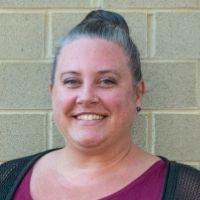
Adaptated Investigation for Students with Blindness and Low Vision
Developed by Connor Pearson, Sr. Chemistry major in the Boardman lab; Dr. Brycelyn Boardman; and Lindsey Sequiera (lead facilitator).
Spring semester (Jan 30-April 28) availability:
Tuesdays and Thursdays 9 - 3
Not available Feb. 16th, March 13th-17th, April 11th, 15th, and 18th
Description
Have you ever wondered what could possibly replace the single-use plastics we use every day? The rapid rise of sustainable alternatives like metal straws and canvas bags still don’t fully replace the millions of tons of plastic waste generated around the world every day. In this session, students will learn about bioplastics- a rapidly growing field of research that combines materials science and biochemistry, plastic pollution and polymerization. Students will have the chance to get in the lab and create their own biopolymers, analyze their own data and learn to interpret data in a variety of formats. By the end of the session, students will have developed an understanding of polymerization, data representation and analysis and the complex issues surrounding the global plastic waste problem.
Overview of What Your Students Will Be Doing
-
Introduction to Polymerization & Bioplastics
-
Lab Safety & Technique Demonstrations
-
Experimentation Part 1: Students will use their provided SOP and data tables to create their bioplastic film samples. The initial steps of the experiment including mixing the necessary reagents before the films must be left to sit and cure undisturbed.
-
Data Analysis & Plastic Pollution Discussion: While the plastics cure, students will be escorted to available meeting/classroom spaces for the data analysis portion of the session. Students will be presented with data representing the sources, causes and complications associated with plastic pollution and recycling and will learn how to interpret various data formatting while exploring and discussing potential solutions and the impact they can make on the problem.
-
Experimentation Part 2: Students will examine their bioplastics and devise a system for rating several plastic characteristics.
-
Concluding Discussion
Differentiation
High school students will work within their groups to develop a way to quantitatively analyze the characteristics of their plastics and will receive more detail as to the chemical makeup of the biopolymers being made. Middle school students will be given a numeric scale for assessing their bioplastics.
Helpful Background Knowledge
-
Scientific method/ scientific inquiry cycle
-
Basic understanding of molecular structure (i.e. atoms, chemical bonds)
-
Basic understanding of plastic pollution (i.e. plastic waste is a long-term problem across the globe, plastic pollution has impacts on environment and human health, lack of widespread plastic recycling programs)
Transferable STEM Skills Practiced
The Process of Science: The varying formulations of bioplastics will allow students to form hypotheses, conduct an experiment, and analyze their results.
Quantitative Reasoning: Students will assign numeric values to qualitative characteristics or develop a method to quantitatively assess plastic characteristics.
Systems Thinking: Students will explore the systems surrounding plastic generation and recycling along with the impacts of GDP and funding on recycling programs.
Data Interpretation/Analysis: Students will collect and analyze the data from their experiment.
Data Visualization: Students will be shown different ways that data can be presented and explore how different visualizations can impact an audience.
Wet Chemistry Techniques & Lab Safety: Students will gain experience using lab equipment such as syringes, magnetic stir rods and hot plates alongside best practices for lab safety.
Cross-Disciplinary Connections
Biology: Bioplastics, made from biological materials like plants, are an attractive alternative to petroleum-based plastics due to their ability to degrade, or break down, by natural processes within a timely manner.
Chemistry: Polymerization is the process in which plastics are made; when short monomers combine to form long polymers.
Environmental Science: Plastic pollution impacts natural ecosystems, food chains and human health in addition to the impact to climate change.
Mathematics: Mathematics is the language of science. Scientists strive to quantify their results to allow their results to be predicted by reproducible mathematical laws and theories.
Connections to JMU Chemistry & Biochemistry Teaching and Research
The experiments that students will conduct in this session are nearly exact replicas of the experiments being done at JMU to help solve the plastic pollution problem. Chemists both at JMU and around the world are working tirelessly to develop solutions to the threats posed by the improper disposal of plastics.
Examples of Connections to Real-World Challenges
Single-use plastics, or plastics that cannot be recycled, are a major environmental concern. Most single-use plastics are used in containers, like takeout containers from your favorite restaurant, or packaging, like the wrap surrounding paper towels or toilet paper. In 2018, 14.5 million tons of these kinds of plastics were thrown away. (“Plastics: Material-Specific Data | US EPA”)
These plastics are sent to landfills, however, unlike food waste which biodegrades relatively quickly, plastics can take anywhere from 20 to 500 years to biodegrade. (“The Lifecycle of Plastics – WWF-Australia - WWF-Australia”) Unfortunately, most plastics aren’t recycled and many aren’t properly disposed of at all, a fact that prompted the U.S. Department of the Interior to issue an order to phase out single-use plastics on public lands on June 8th, 2022. More than 14 million tons of plastic waste ends up in our planet’s oceans every year, in fact 80% of ocean debris is some form of plastic. (“Secretary Haaland Issues Order to Phase Out Single-Use Plastics, Protect Public Lands and Waters | U.S. Department of the Interior”) Plastic bags have even been found at the bottom of the Mariana Trench, over 36,000 feet under the sea. (Gibbens) Plastic pollution does more than float around the oceans however. Animals on both land and sea can die from ingesting plastics and they can also spread invasive species which destroy local habitats. Plastics can also leach chemicals into their environments, poisoning both humans and wildlife alike. Often, plastics in the ocean break down into indigestible microplastics. Not only is this process dangerous due to the health hazards posed by the buildup of plastics within the body, but it also contributes to climate change as methane gas is released into the atmosphere. (Molloy) Microplastics have been found in human blood and even lung tissue which causes respiratory disease. (Jenner et al.)
There is no easy solution to the world’s plastic waste problems and dependency, however, the development of products like bioplastics, or plastics made from biological materials like plants, offer hope. Bioplastics offer attractive alternatives to single-use plastics for various applications including food packaging, agriculture and even hygiene products as they can be recycled or even composted easily. (Rudin and Choi)
Works Cited
1. “Plastics: Material-Specific Data | US EPA.” Plastics: Material-Specific Data, www.epa.gov, 12 Sept. 2017, https://www.epa.gov/facts-and-figures-about-materials-waste-and-recycling/plastics-material-specific-data.
2. “The Lifecycle of Plastics – WWF-Australia - WWF-Australia.” The Lifecycle of Plastics – WWF-Australia - WWF-Australia, www.wwf.org.au, 1 July 2021, https://www.wwf.org.au/news/blogs/the-lifecycle-of-plastics.
3. “Secretary Haaland Issues Order to Phase Out Single-Use Plastics, Protect Public Lands and Waters | U.S. Department of the Interior.” Secretary Haaland Issues Order to Phase Out Single-Use Plastics, Protect Public Lands and Waters | U.S. Department of the Interior, www.doi.gov, 8 June 2022, https://www.doi.gov/pressreleases/secretary-haaland-issues-order-phase-out-single-use-plastics-protect-public-lands-0#:~:text=Single%2Duse%20plastic%20products%20include,be%20used%20once%20and%20discarded.
4. Gibbens, Sarah. “Plastic Bag Found at the Bottom of World’s Deepest Ocean Trench | National Geographic Society.” Plastic Bag Found at the Bottom of World’s Deepest Ocean Trench | National Geographic Society, education.nationalgeographic.org, 2 June 2022, https://education.nationalgeographic.org/resource/plastic-bag-found-bottom-worlds-deepest-ocean-trench.
5. Molloy, Shen et al. “Opportunities for single-use plastic reduction in the food service sector during COVID-19.” Sustainable production and consumption vol. 30 (2022): 1082-1094. doi:10.1016/j.spc.2022.01.023
6. Jenner, Lauren, et al. “Detection of Microplastics in Human Lung Tissue Using μFTIR Spectroscopy - ScienceDirect.” Science of the Total Environment, vol. 831, www.sciencedirect.com, 29 Mar. 2022.
7. Rudin, Alfred, and Phillip Choi. The Elements of Polymer Science & Engineering : Chapter 13. 3rd ed., www.sciencedirect.com, 2012.
Related Careers
Environmental chemists use their understanding of chemistry to study how different materials degrade in the environment and how different materials impact environmental health and wellness. Environmental chemists can work for government agencies like the Environmental Protection Agency, companies that produce products or even universities like JMU.
Polymer scientists like Dr. Stacy Trey use their knowledge of chemistry and engineering to design new materials or improve materials that have already been made. Many polymer scientists design with sustainability in mind to develop products that won’t harm the environment or consumers.
To Share with Your Students Before the Visit
This short (~2 min) video showcases the work of the Anderson twins, two brothers based out of California that are producing a bioplastic alternative for traditional single-use packaging that breaks down easily in seawater with no toxic effects.
Extra Background Information for Teachers
-
The University of Akron provides a wealth of polymer resources here, including lesson plans and educational videos for K-12 students.
-
The American Chemical Society’s Chemistry in Context series features a lesson on polymers, plastics and plastic degradation here, including videos.
-
The Agricultural Science department at Oregon State University has a lesson plan for bioplastics here, including a short article on plastics, polymers and biodegradable plastics.



